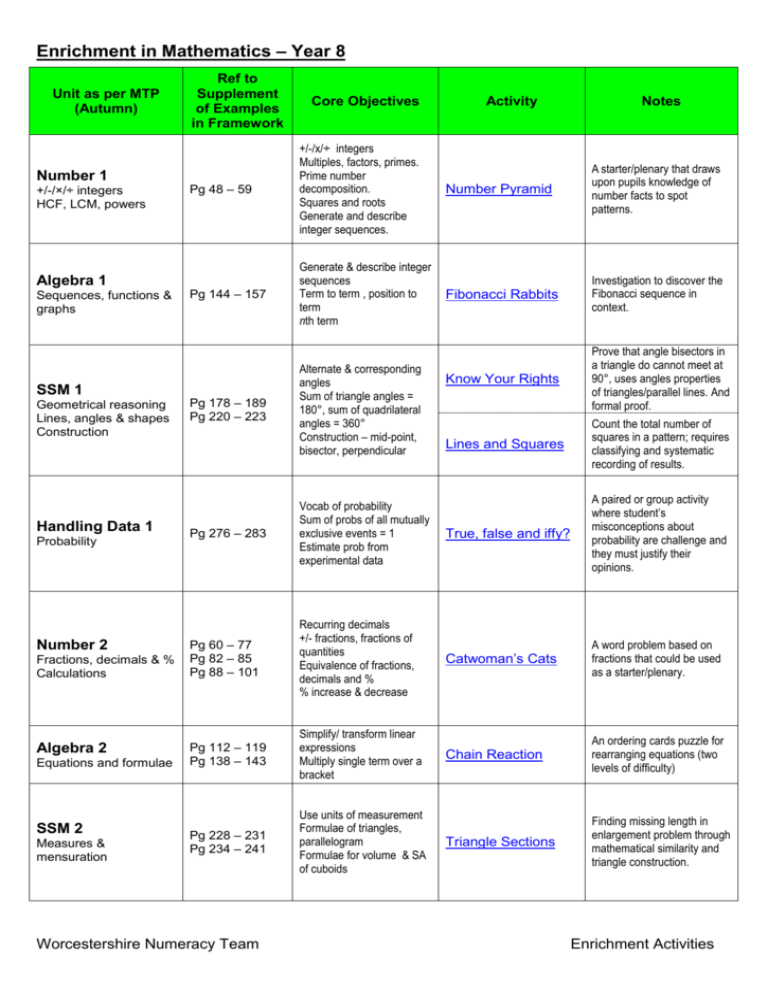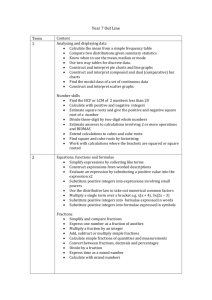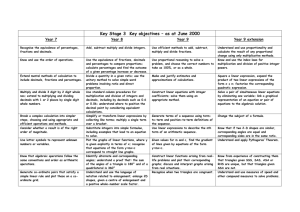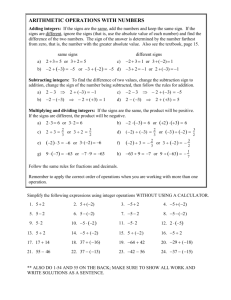Enrichment references to KS3 (Y8) WEBSITE VERSION
advertisement

Enrichment in Mathematics – Year 8 Unit as per MTP (Autumn) Number 1 +/-/×/÷ integers HCF, LCM, powers Algebra 1 Sequences, functions & graphs SSM 1 Geometrical reasoning Lines, angles & shapes Construction Handling Data 1 Probability Number 2 Fractions, decimals & % Calculations Algebra 2 Equations and formulae SSM 2 Measures & mensuration Ref to Supplement of Examples in Framework Core Objectives Activity Notes Pg 48 – 59 +/-/x/÷ integers Multiples, factors, primes. Prime number decomposition. Squares and roots Generate and describe integer sequences. Number Pyramid A starter/plenary that draws upon pupils knowledge of number facts to spot patterns. Pg 144 – 157 Generate & describe integer sequences Term to term , position to term nth term Fibonacci Rabbits Investigation to discover the Fibonacci sequence in context. Know Your Rights Prove that angle bisectors in a triangle do cannot meet at 90°, uses angles properties of triangles/parallel lines. And formal proof. Lines and Squares Count the total number of squares in a pattern; requires classifying and systematic recording of results. Pg 276 – 283 Vocab of probability Sum of probs of all mutually exclusive events = 1 Estimate prob from experimental data True, false and iffy? A paired or group activity where student’s misconceptions about probability are challenge and they must justify their opinions. Pg 60 – 77 Pg 82 – 85 Pg 88 – 101 Recurring decimals +/- fractions, fractions of quantities Equivalence of fractions, decimals and % % increase & decrease Catwoman’s Cats A word problem based on fractions that could be used as a starter/plenary. Pg 112 – 119 Pg 138 – 143 Simplify/ transform linear expressions Multiply single term over a bracket Chain Reaction An ordering cards puzzle for rearranging equations (two levels of difficulty) Pg 228 – 231 Pg 234 – 241 Use units of measurement Formulae of triangles, parallelogram Formulae for volume & SA of cuboids Triangle Sections Finding missing length in enlargement problem through mathematical similarity and triangle construction. Pg 178 – 189 Pg 220 – 223 Worcestershire Numeracy Team Alternate & corresponding angles Sum of triangle angles = 180°, sum of quadrilateral angles = 360° Construction – mid-point, bisector, perpendicular Enrichment Activities Enrichment in Mathematics – Year 8 Unit as per MTP (Spring) Algebra 3 Sequences, functions, graphs Number 3 Place value Calculations Calculator methods SSM 3 Geometrical reasoning Transformations Mensuration Ratio & proportion Algebra 4 Equations and formulae Handling Data 2 Handling data project Ref to Supplement of Examples in Framework Core Objectives Pg 160 – 177 Express simple functions Plot graphs of linear functions Real-life graphs Pg 36 – 47 Pg 92 – 107 Pg 110 – 111 ×/÷ of integers & decimals Calculation estimates & approximations Entering & interpretation of calc displays Pg 190 – 191 Pg 202 – 215 Pg 78 – 81 Congruence Translation/rotation/ reflection Enlargements – implications Use proportional reasoning to solve a problem, use ratio in a range of contexts. Pg 112 – 113 Pg 122 – 125 Pg 138 – 143 Construct & solve linear equations Substitute integers into simple formulae Pg 248 – 273 Handling data project: Construct pie charts, bar charts, frequency diagrams (discrete data) & simple scatter graphs Worcestershire Numeracy Team Activity Notes Temperature A good plenary activity to extend skills on solving simultaneous equations. Ink Blots Plenary/homework task that provides opportunity for pupils to apply their knowledge of multiplication/division facts. Also allows practice of calculator skills. Arrowheads Geogebra file Finding missing length in enlargement problem through mathematical similarity and triangle construction. Similar Cylinders Finding missing length in enlargement problem through mathematical similarity and triangle construction. Diagonal Sums An open-ended investigation that can last a whole lesson or be extended. Pupils can pose their own questions and follow their own lines of enquiry. Pupils will solve problems, represent problems using symbols, words and diagrams and use algebra to generalise. Estimation task An investigation from a given hypothesis based around ability at estimation. Students can collect, sample, organise, represent and interpret their own data. Enrichment Activities Enrichment in Mathematics – Year 8 Unit as per MTP (Summer) Number 4 Calculations Measures Algebra 5 Equations, & formulae Sequences, functions & graphs SSM 4 Geometrical reasoning Lines, angles & shapes Transformations Construction & loci Mensuration Handling Data 3 Handling data project Probability Ref to Supplement of Examples in Framework Core Objectives Pg 82 – 87 Pg 92 – 107 Pg 110 – 111 Pg 228 – 231 +/- of fractions & integers, ×/÷ of integers Order of operations Estimates & approximations Standard column ×/÷ of integers & decimals Pg 116 – 137 Pg 164 – 177 Transform linear expressions Construct & solve linear equations Plot graphs of linear functions Real line graphs Pg 198 – 201 Pg 216 – 227 Pg 232 – 233 Pg 238 – 241 Know & use geometric properties Scale drawings, plans & elevations Use ruler & compass to construct triangles (SSS) Simple loci Volume and SA of cuboids Pg 248 – 275 Pg 284 – 285 Handling data project: Construct bar charts, frequency diagrams (continuous data) & simple line graphs (time series) Estimation from experimental Compare theoretical & experimental Worcestershire Numeracy Team Activity Notes All the Four’s Using all operations, roots and squares to make totals. Can be made into a short or longer activity! Age-Old Problems A plenary activity to reinforce skills on solving problems involving simultaneous equations. Pupils may try trial and error to start with but then move to an algebraic method - useful discussion point. How Far?? Given information about the distance between a sequence of points, find positions. What's wrong? Possible or impossible? A selection of misleading statistics and graphs for students to identify problems and suggest methods to improve. An activity where statements are presented to students and they have to decide whether they can find cases to verify the statements. Enrichment Activities







